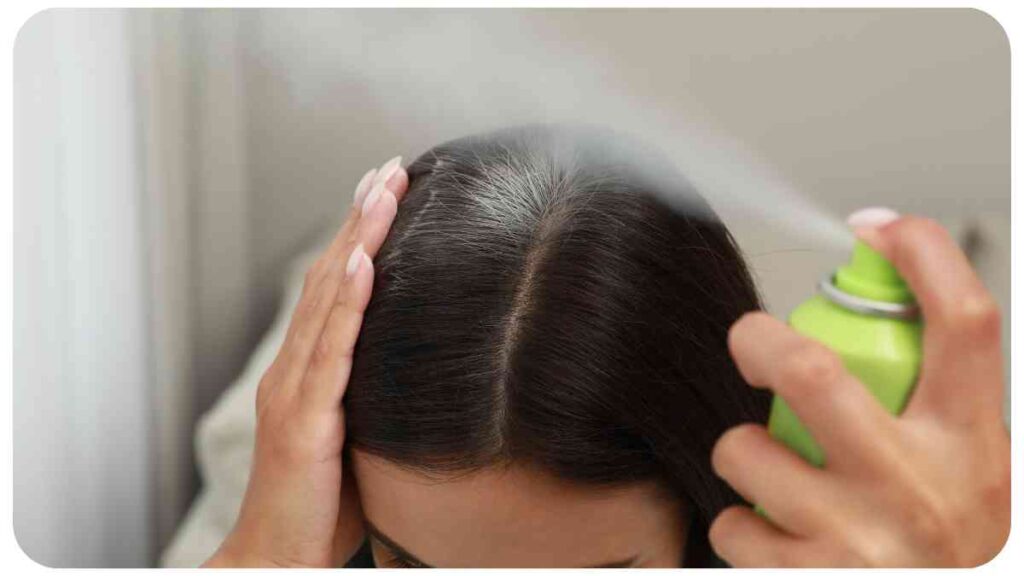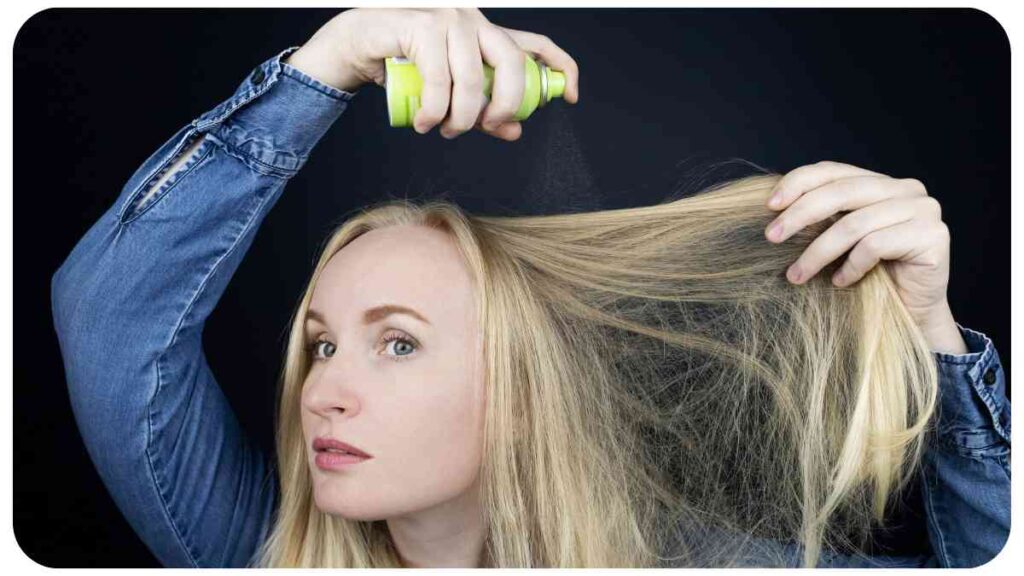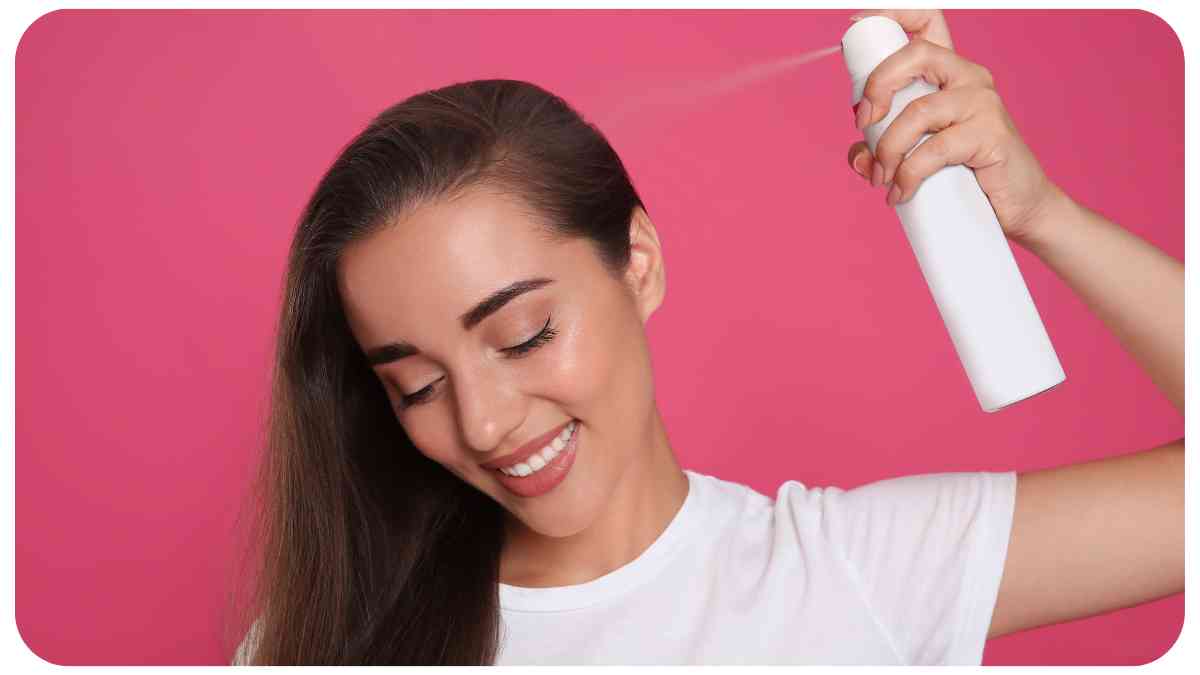Welcome to our comprehensive guide on dry shampoo! In this article, we will delve into the world of dry shampoo, exploring its pros and cons, and providing you with essential insights to make an informed decision on whether it’s the right choice for you.
Dry shampoo has gained popularity in recent years as a convenient and time-saving alternative to traditional shampoo and water-based cleansing. It offers a quick solution for refreshing hair, especially during hectic mornings or on-the-go situations.
However, like any beauty product, dry shampoo has its advantages and disadvantages. So, let’s dive in, examine the pros and cons, and discover what you need to know about dry shampoo.
| Takeaways |
| – Dry shampoo can be a convenient solution for refreshing hair between washes. |
| – It is not a substitute for regular shampooing, and regular washing is still necessary for maintaining scalp and hair health. |
| – Proper application and distribution of dry shampoo, focusing on the roots, can help achieve optimal results. |
| – Overusing dry shampoo can lead to product build-up, scalp irritation, and dull-looking hair. Use it in moderation. |
| – Consider your hair type, ingredients, scent, and application method when choosing a dry shampoo. |
| – DIY dry shampoo recipes offer a natural and customizable alternative to store-bought options. |
| – Follow best practices, such as avoiding heat styling immediately after applying dry shampoo and washing it out regularly. |
| – Dry shampoo is not suitable for everyone, and individuals with certain scalp conditions should consult a professional before use. |
Understanding Dry Shampoo: How It Works
Dry shampoo is a powder or aerosol spray that is used to cleanse the hair between traditional shampoos without the need for water. It works by absorbing excess oil and sebum from the hair and scalp, leaving the hair looking and feeling refreshed. Dry shampoo typically contains ingredients such as starch, talc, or clay that absorb the oils, dirt, and odor from the hair.
Benefits of Using Dry Shampoo

Dry shampoo offers several benefits that make it a popular choice among individuals with various lifestyles and hair types. Let’s take a closer look at some of these benefits:
- Time-saving: One of the major advantages of using dry shampoo is the time it saves. Unlike traditional shampoo, which requires water, rinsing, and drying, dry shampoo can be applied directly to the hair to absorb oil and refresh the hair within minutes.
- Convenience: Dry shampoo is a convenient option, especially when you are on the go or have a hectic schedule. It is ideal for quick touch-ups or when you don’t have access to water, making it a travel-friendly choice.
- Extended hairstyle: By reducing excess oil and grease, dry shampoo helps extend the life of your hairstyle. It can grant you an extra day or two before requiring a full wash, making it perfect for individuals with busy schedules.
- Adds volume and texture: Dry shampoo has a texturizing effect on the hair, adding volume and body. It can help create a more voluminous and textured look, making it especially beneficial for those with fine or limp hair.
- Preserves natural oils: Unlike traditional shampoo, which can strip the hair of its natural oils, dry shampoo maintains the hair’s natural oils. This can prevent the hair and scalp from becoming dry, which is particularly advantageous for individuals with dry or sensitive scalps.
These are just a few of the many benefits dry shampoo has to offer. It’s important to remember that different hair types and needs may require different considerations when using dry shampoo. Now, let’s explore some of the drawbacks of dry shampoo to provide a well-rounded view.
When dealing with acne-prone skin, it’s important to choose the right products that won’t clog pores. Explore the best skincare products for acne-prone skin to effectively manage breakouts and promote clearer skin.
Drawbacks of Using Dry Shampoo
While dry shampoo can be a game-changer for many, it’s crucial to understand its limitations and drawbacks. Here are a few points to consider:
- Build-up and residue: Dry shampoo can leave a build-up of product and residue on the scalp and hair if not used properly or if used excessively. This can lead to dullness, product build-up, and even clog hair follicles if not washed out regularly.
- Limited cleansing properties: Dry shampoo serves as a temporary solution to refresh the hair, but it doesn’t offer the same cleansing power as traditional shampoo. It can’t remove sweat, dirt, or product build-up as effectively as water-based shampoo.
- Potential scalp irritation: Some individuals may experience scalp irritation or dryness when using dry shampoo regularly. It is essential to pay attention to your scalp’s reaction and discontinue use if any adverse effects occur.
- Not suitable for all hair types: While dry shampoo works well for most hair types, it may not be suitable for everyone. Individuals with extremely dry or oily scalps, sensitive scalps, or certain scalp conditions should consult with a hairstylist or dermatologist before incorporating dry shampoo into their hair care routine.
Now that we have discussed the benefits and drawbacks of dry shampoo, let’s move on to considering some important factors when choosing the right product for your hair.
Factors to Consider When Choosing a Dry Shampoo
Choosing the right dry shampoo can greatly enhance your experience and ensure optimal results. Consider the following factors when making your selection:
- Hair type: Different dry shampoos are formulated to cater to specific hair types. Whether you have fine, thick, curly, or colored hair, there are dry shampoos available specifically designed to address the needs of your hair type. Look for options that mention suitability for your hair type on the packaging.
- Ingredients: Pay attention to the ingredients used in the dry shampoo. Avoid products that contain harsh chemicals or allergens that may cause irritation. Opt for gentle formulas with natural ingredients that are safe for your hair and scalp.
- Scent: Dry shampoos often come with various fragrances that can mask the odor in your hair and leave it smelling fresh. Choose a scent that you find pleasant and consider if it might clash with any other styling products you use.
- Application: Dry shampoos are available in different formats, such as powders, aerosols, and sprays. Consider which application method you prefer and find most convenient for your needs.
- Reviews and recommendations: Reading reviews and seeking recommendations from others who have tried different dry shampoos can be helpful in finding the right product. Take note of feedback regarding effectiveness, residue, scent, and overall satisfaction.
By considering these factors, you can select a dry shampoo that best suits your hair type, preferences, and requirements. Now, let’s move on to learn how to properly apply dry shampoo for optimal results.
How to Properly Apply Dry Shampoo

Applying dry shampoo correctly is essential to achieve the best results and avoid any potential issues. Follow these steps for effective application:
- Start with dry hair: Dry shampoo should be applied to dry hair. Ensure your hair is not damp or wet from any recent styling or washing.
- Section your hair: Divide your hair into sections to ensure even distribution of the dry shampoo. This will help prevent any patchy or uneven application.
- Shake the can or bottle: Shake the dry shampoo can or bottle well before use to mix the powder or formula properly.
- Spray or sprinkle: Depending on the type of dry shampoo you have, either spray it directly onto the roots, holding the can 6-8 inches away, or sprinkle the powder onto the roots. Focus on the areas where your hair tends to get greasy or oily.
- Massage and wait: Gently massage the dry shampoo into your scalp using your fingertips or a brush. This will help distribute the product and absorb the excess oils. Allow the dry shampoo to sit for a couple of minutes to absorb the oils thoroughly.
- Brush or comb: After the waiting period, brush or comb through your hair to remove any residue and evenly distribute the dry shampoo. This will give your hair a refreshed and volumized appearance.
Remember, the amount of dry shampoo needed may vary depending on your hair type, thickness, and level of oiliness. Start with a small amount, and if necessary, gradually add more until you achieve the desired results. With practice, you’ll find the right balance for your hair.
Now, if you prefer a more natural approach to hair care or want to give yourself more control over the ingredients, you can even make your own DIY dry shampoo. Let’s explore some simple recipes.
Achieve salon-quality results from the comfort of your own home with the help of the ultimate guide to at-home manicures. Discover valuable tips and steps to create beautiful nails without a trip to the salon.
DIY Dry Shampoo Recipes
Creating your own dry shampoo allows you to customize the ingredients and tailor it to your specific needs. Here are a couple of easy DIY dry shampoo recipes you can try:
Recipe 1: Basic Cornstarch Dry Shampoo
Ingredients:
- ¼ cup cornstarch
- 2-3 drops essential oil (optional)
Instructions:
- In a bowl, combine the cornstarch and essential oil, if desired.
- Mix well until the ingredients are evenly distributed.
- Transfer the mixture to a clean, airtight container or an empty spice jar.
- To use, simply apply a small amount of the mixture to the roots of your hair and massage it in. Brush out any excess.
Recipe 2: Cocoa Powder Dry Shampoo (For Dark Hair)
Ingredients:
- 2 tablespoons cocoa powder
- 2 tablespoons arrowroot powder (or cornstarch for a lighter shade)
- 5-6 drops essential oil (optional)
Instructions:
- In a bowl, combine the cocoa powder and arrowroot powder.
- Add the essential oil, if desired, for fragrance.
- Mix well until the ingredients are thoroughly blended.
- Transfer the mixture to a clean, airtight container.
- To use, apply a small amount to the roots of your hair, focusing on the areas that need refreshing. Massage it in and brush out any excess powder.
These DIY dry shampoo recipes provide a natural and cost-effective alternative to store-bought options. Experiment with different ingredients and ratios to find the perfect blend for your hair.
Moving forward, let’s discuss some best practices for using dry shampoo to maximize its benefits and minimize any potential downsides.
Best Practices for Using Dry Shampoo
To ensure the best results and avoid any adverse effects, follow these best practices when using dry shampoo:
- Don’t overuse: While dry shampoo can be a convenient solution, it is not a substitute for regular hair washing. It is best used as a temporary solution between washes. Overusing dry shampoo can lead to product build-up, scalp irritation, and dull-looking hair.
- Focus on roots: When applying dry shampoo, concentrate on the roots of your hair, as this is where oil tends to accumulate the most. Applying it to the lengths and ends of your hair may cause dryness or make the hair appear dull.
- Brush and blend: After applying dry shampoo, thoroughly brush or comb your hair to distribute the product and avoid any visible residue. This will also help create volume and a refreshed appearance.
- Avoid heat styling: Dry shampoo can be prone to flammability due to its powder or aerosol form. Take caution and avoid using heat styling tools immediately after applying dry shampoo to prevent any potential hazards.
- Wash it out: It is important to wash your hair regularly to remove any product build-up and maintain the overall health of your hair and scalp. Dry shampoo should not replace regular washing, but rather serve as a temporary solution when needed.
By following these best practices, you can maximize the benefits of dry shampoo while minimizing any potential drawbacks. Now, let’s compare dry shampoo to traditional shampoo and see which option comes out on top.
Enhance your makeup skills and achieve flawless results with these 10 secrets to achieve flawless makeup every time. Learn how to perfect your techniques and create stunning looks for any occasion.
Dry Shampoo vs. Traditional Shampoo: Which is Better?
The debate between dry shampoo and traditional shampoo often sparks discussions among beauty enthusiasts. Both options have their pros and cons, and the right choice depends on individual preferences and specific circumstances. Let’s explore each option:
Dry Shampoo
- Pros:
- Time-saving and convenient
- Extends the life of hairstyles
- Adds volume and texture
- Suitable for on-the-go situations and travel-friendly
- Preserves natural oils
- Cons:
- Potential build-up and residue
- Limited cleansing properties
- May cause scalp irritation
- Not suitable for all hair types
- Should not replace regular washing
Traditional Shampoo
- Pros:
- Thoroughly cleanses the hair and scalp
- Removes dirt, sweat, and product build-up effectively
- Provides a fresh and clean feeling
- Suitable for all hair types and scalp conditions
- Offers a wide variety of formulas for specific needs
- Cons:
- Requires water, rinsing, and drying
- Can strip natural oils from the hair and scalp
- Time-consuming, especially with elaborate hairstyles
Ultimately, the choice between dry shampoo and traditional shampoo depends on your lifestyle, hair type, and personal preferences. Dry shampoo is a great option for quick touch-ups, extending hairstyles, and on-the-go situations. However, regular use should be complemented with regular washing to maintain scalp and hair health.
Now, let’s address some frequently asked questions (FAQs) to provide further guidance and clarity on using dry shampoo.
Ensure proper protection from the sun’s harmful rays by learning how to properly apply sunscreen. Follow these tips and tricks to safeguard your skin from sunburn and reduce the risk of sun damage.
Frequently Asked Questions (FAQs)
Can dry shampoo cause hair damage?
When used correctly and in moderation, dry shampoo should not cause hair damage. However, excessive use or improper application may lead to product build-up, scalp irritation, or dryness. It is advisable to follow the instructions provided by the manufacturer and wash your hair regularly.
Can dry shampoo replace regular shampooing?
Dry shampoo is not a replacement for regular shampooing. It serves as a temporary solution when you don’t have access to water or need to refresh your hair on the go. Regular washing is essential to maintain a healthy scalp and remove any product or oil build-up.
Can I use dry shampoo on colored or chemically-treated hair?
Dry shampoo is generally safe to use on colored or chemically-treated hair. However, it is recommended to choose a dry shampoo specifically formulated for colored hair to ensure it won’t strip the color or cause any damage. It’s always best to check the product label for any specific instructions or recommendations.
Encountering hair straightener issues? Troubleshoot the common problems with ease using this quick guide for troubleshooting common hair straightener issues. Find useful tips and solutions to ensure optimal performance and styling results.
How often can I use dry shampoo?
Dry shampoo can be used as needed between regular washes.
Conclusion
In conclusion, dry shampoo can be a convenient tool to refresh your hair, extend hairstyles, and save time between regular washes. It absorbs excess oil, adds volume, and can be a great solution for on-the-go situations. However, it should not replace regular shampooing, as proper cleansing is necessary for maintaining scalp and hair health.
When choosing a dry shampoo, consider your hair type, ingredients, scent, application method, and reviews. Proper application involves starting with dry hair, sectioning it for even distribution, massaging the product into the roots, allowing it to absorb, and then brushing or combing it out.
If you prefer a more natural approach, you can make your own DIY dry shampoo using ingredients like cornstarch, cocoa powder, and essential oils.
It’s important to follow best practices such as not overusing dry shampoo, focusing on the roots, brushing and blending to remove any residue, and not using heat styling immediately after application.
Dry shampoo is not without its drawbacks, including potential product build-up, scalp irritation, and limited cleansing properties. Additionally, it may not be suitable for all hair types or conditions.
In the dry shampoo vs. traditional shampoo debate, both options have their advantages and disadvantages. Dry shampoo is great for quick touch-ups and convenience, while traditional shampoo provides thorough cleansing. Ultimately, the choice depends on your personal preferences and circumstances.
Remember to consult with hairstylists or dermatologists if you have any specific scalp conditions or concerns before incorporating dry shampoo into your routine.
By considering these factors, following best practices, and understanding the limitations of dry shampoo, you can effectively use it as a tool for refreshing your hair and maintaining its health and appearance.
Further Reading
Here are some additional resources for further reading on dry shampoo:
Skinkraft: Dry Shampoo and How to Use It: This article provides information on dry shampoo, its benefits, and tips on how to use it effectively.
Buzzfeed: The Good and Bad of Dry Shampoo for Your Hair: This Buzzfeed article discusses the pros and cons of using dry shampoo and provides insights into potential effects on hair.
Yogi Cosmetics: The Pros and Cons of Using Dry Shampoo – What You Need to Know: Yogi Cosmetics explores the advantages and disadvantages of dry shampoo, highlighting important considerations when incorporating it into your hair care routine.

Hi, you! I’m Hellen James. I’m a beauty and fashion writer who loves to make the world a little more stylish and I’d love for you to join me in the fun! I’ve been writing about beauty and fashion since I was a kid, but it wasn’t until recently that I really knew what it meant to be a real expert.

